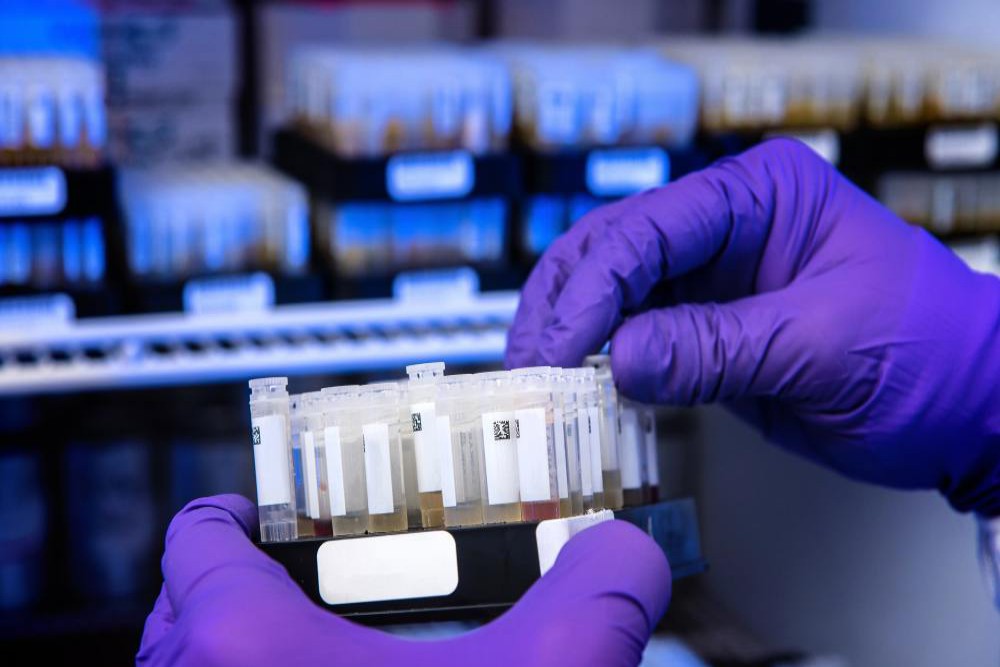DNA, short for deoxyribonucleic acid, is a molecule that contains the genetic instructions for the development, functioning, growth, and reproduction of all known living organisms. It is often referred to as the "building blocks of life" and plays a crucial role in genetics and molecular biology.
DNA is a double-stranded helix made up of nucleotides. Each nucleotide consists of a sugar molecule (deoxyribose), a phosphate group, and a nitrogenous base. The nitrogenous bases adenine (A), thymine (T), cytosine (C), and guanine (G) pair up in a specific way: A with T and C with G.
DNA carries the genetic information that determines an organism's traits and characteristics. It serves as a blueprint for the synthesis of proteins, which are essential for various biological processes. DNA replication is crucial for cell division and growth.
DNA was first identified by Swiss biochemist Friedrich Miescher in the late 19th century. However, it was not until the early 1950s that James Watson and Francis Crick proposed the double helix structure of DNA, based on X-ray diffraction data collected by Rosalind Franklin.
DNA replication is the process by which a cell makes an identical copy of its DNA. It is essential for cell division and growth, as each new cell needs a complete set of genetic instructions. The process involves unwinding the double helix, separating the strands, and synthesizing new complementary strands.
Transcription is the process by which DNA is converted into messenger RNA (mRNA) by RNA polymerase. The mRNA carries the genetic information from the DNA to the ribosomes, where translation takes place. During translation, the mRNA is read by ribosomes to synthesize proteins based on the genetic code.
Mutations are changes in the DNA sequence that can result from errors during replication, exposure to mutagens, or other factors. Some mutations can be harmful and lead to genetic disorders, while others may have no effect or even provide an advantage in certain environments.
Genetic engineering involves manipulating the DNA of an organism to introduce new traits or characteristics. This can be done through techniques such as gene editing, gene splicing, and gene cloning. Genetic engineering has applications in agriculture, medicine, and biotechnology.
Forensic DNA analysis is a technique used in criminal investigations to identify individuals based on their DNA profiles. DNA evidence can be collected from crime scenes, suspects, and victims, and compared to DNA databases to determine matches. It has revolutionized the field of forensic science.
The Human Genome Project was an international research initiative that aimed to map and sequence the entire human genome. It was completed in 2003, providing a comprehensive understanding of the genetic makeup of humans. The project has led to advances in personalized medicine, genetics, and biotechnology.
DNA analysis has revolutionized our understanding of evolutionary history and relationships between species. By comparing DNA sequences, scientists can reconstruct evolutionary trees and trace the genetic similarities and differences between organisms. This field of study is known as molecular phylogenetics.

DNA technology has numerous medical applications, including genetic testing, gene therapy, and personalized medicine. Genetic testing can identify genetic predispositions to diseases, while gene therapy aims to treat genetic disorders by replacing or repairing faulty genes. Personalized medicine uses genetic information to tailor treatments to individual patients.
Environmental DNA (eDNA) refers to the genetic material found in environmental samples such as soil, water, and air. eDNA analysis can be used to detect and identify species present in an ecosystem without directly observing them. This non-invasive technique has applications in biodiversity monitoring and conservation efforts.
DNA barcoding is a method used to identify species based on short DNA sequences from a standardized region of the genome. It is particularly useful for identifying species that are difficult to distinguish based on morphology alone. DNA barcoding has applications in taxonomy, ecology, and conservation biology.
Epigenetics is the study of changes in gene expression that are not caused by alterations in the DNA sequence. These changes can be influenced by environmental factors, lifestyle choices, and other external stimuli. Epigenetic modifications can have long-lasting effects on gene activity and phenotype.
孩子长痱子的原因很多时候与体内湿热有关,因此在饮食方面也需要进行调理。家长可以给孩子多喝水,帮助排出体内的毒素和废物,减少湿热的产生。还可以给孩子多吃一些清热解毒的食物,比如黄瓜、西瓜、苦瓜等,有助于改善体内的湿热状况。
要避免患者抓挠水泡。水泡破裂后会引起疼痛和瘙痒,但抓挠会导致细菌感染和疤痕留下,所以要告诫患者不要抓挠水泡。
对于严重症状的红痱子,可以考虑使用药物治疗。常见的药物包括外用的抗瘙痒药膏、消炎药膏等。在使用药物治疗时,应根据医生的建议选择合适的药物,遵循药物使用说明书上的用药方法和剂量,避免过度使用。如果症状持续加重或出现其他不适,应及时就医。
CRISPR-Cas9 is a revolutionary gene-editing technology that allows scientists to precisely modify DNA sequences in living organisms. It is based on a bacterial defense mechanism against viruses and has been adapted for use in genetic engineering. CRISPR-Cas9 has the potential to revolutionize medicine, agriculture, and biotechnology.
Genetic diversity refers to the variety of genetic traits within a population or species. It is essential for the adaptation and survival of organisms in changing environments. Maintaining genetic diversity is crucial for the long-term health and resilience of populations, as it provides the raw material for evolution.
The use of DNA technology raises ethical and legal concerns related to privacy, consent, discrimination, and ownership of genetic information. Issues such as genetic discrimination, genetic privacy, and the use of DNA in law enforcement have sparked debates about the ethical implications of DNA testing and genetic manipulation.
The field of DNA research is constantly evolving, with new technologies and discoveries shaping the future of genetics and molecular biology. Advances in DNA sequencing, gene editing, and synthetic biology hold promise for addressing global challenges in healthcare, agriculture, and the environment. The study of DNA continues to unlock the mysteries of life and drive scientific innovation.
In conclusion, DNA, as the fundamental molecule of life, plays a central role in genetics, molecular biology, and various fields of science. Its structure, function, and applications have revolutionized our understanding of biology and shaped the way we study and manipulate genetic information. As research in DNA technology progresses, the potential for new discoveries and applications in medicine, agriculture, and biotechnology is vast. DNA remains a key focus of scientific inquiry and innovation, driving advancements that have the power to transform the world we live in.